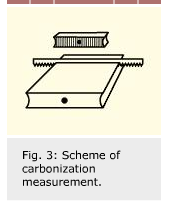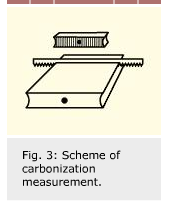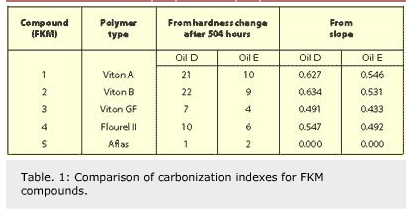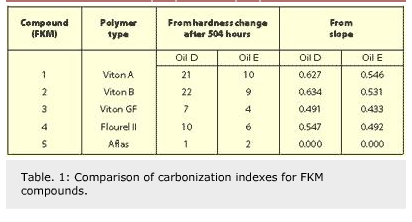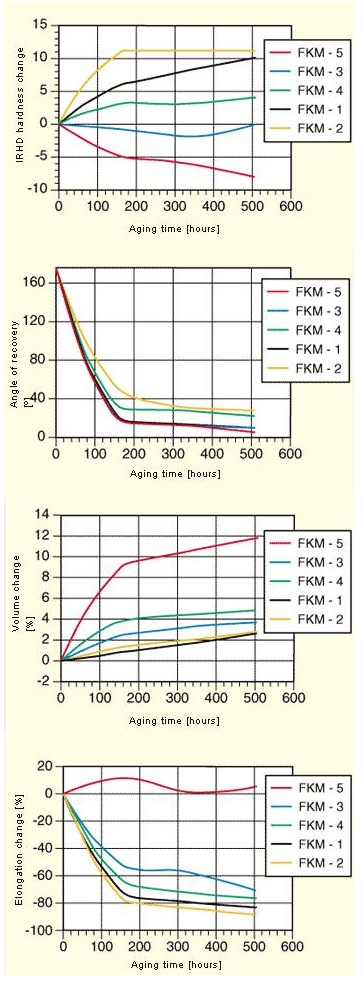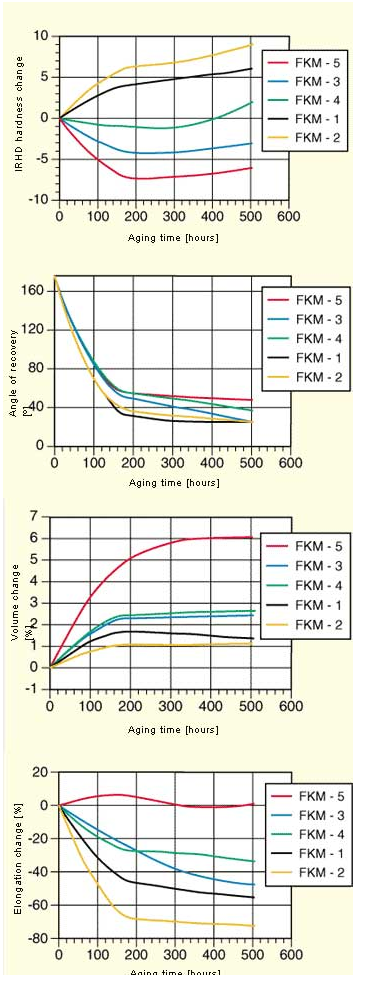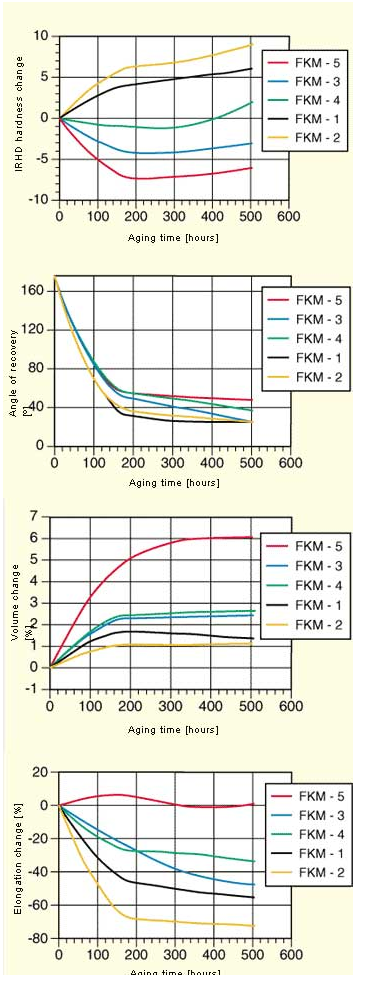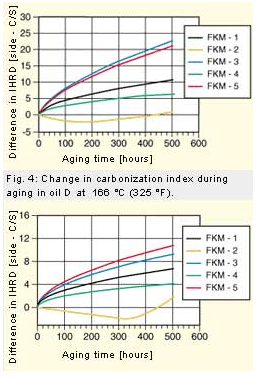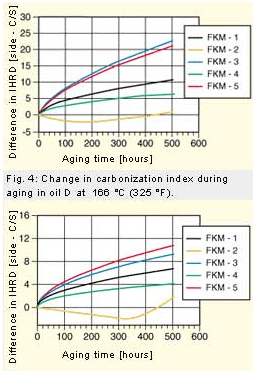
Carbonisation phenomena on dynamic shaft seals
Carbonisation of dynamic shaft seals is a phenomenon that can cause oil leakage. The cause of carbonisation has been studied and suitable test methods developed.
Dynamic shaft seals may leak during use even though the basic rubber member remains flexible and can follow the shaft profile well. In such situations, one reason for seal leakage could be the carbonisation that is created on the lip contact point. The carbonisation phenomenon on the seal lip usually appears on those seal compounds that have high heat resistance, particularly those based on fluoroelastomers.
In some cases, however, seals that had carbonisation on the lip did not leak and ran a very long time. It was not possible to identify if the carbonisation was really the cause of seal leakage. A project was set up to investigate the carbonisation phenomenon and develop a method to measure the carbonisation under laboratory conditions without using the seal bench test.
Experimental aspects
The first part of the project was to evaluate carbonisation phenomena starting with a seal bench test. Differential pinion gear seals were selected with 73.6 mm inside diameter.
Three types of gear oils, designated A, B and C, were used for the tests, each having different thermostability levels. Oil A is considered thermally stable with good L-60 deposit rating, B and C represent two systems with poor thermal stability based on their L-60 performance.
The test conditions used a fluoroelastomer rubber (FKM) compound that is a copolymer with bis phenol cure. The test parameters were:
Oil temperature 110 ºC
Shaft speed 3,500 r/min
Shaft diameter 76.2 mm
STBM 0.254 mm
DRO 0.127 mm
Test conditions 24 hours non stop.
These severe test conditions were selected to create the carbonisation within the shortest running time. The first evaluation of seals from a bench test was carried out after 225 hours. Seals running in thermostable oil A did not show carbonisation on the lip while seals running in the non- thermostable oils B and C demonstrated obvious carbonisation on the lip. None of the three seals leaked and the small amount of carbonisation noted in seals using oils B and C did not initiate oil leakage. The seal bench test was continued with a minimum of six seals tested in each oil.
The seal bench tests demonstrated a very substantial difference in seal life for seals tested in thermostable versus non-thermostable oils. Although there are some differences in seal life between oils B and C, taking into account the variations of seal life test, it was not possible to conclude a substantial difference in seal life between these two oils.
An oil degradation test was provided after each seal leakage, using the previously developed Fourier transform infrared spectroscopy, FTIR, technique. For the oil degradation index (ODI), the values of the ratio of carbonyl peak height at 1707-1713 cm-1 before and after a certain period of seal running time was assumed. This test showed a change of ODI during seal life testing. The phosphorus content also was used to analyse the degradation of oil additives. Both of these tests showed a higher thermostability for oil type A.
Visual inspection after the seal bench test demonstrated that all seals had carbonisation on the seal lip area . It was difficult to separate the level of carbonisation for seals running in different oils. Only a scanning electron microscope (SEM) investigation of seal in cross-section revealed differences. Carbonisation of the seal run in oil A for 3,091 hours without leakage appeared only on the surface of the seal contact area. The seal tested in oil B (leaked after 1,052 hours) showed carbonisation not only on the surface of the seal lip but also in the rubber bulk. The same conclusion could be made for the seal tested in oil C, which leaked after 332 hours.
Comparisons using the X-ray analysis of the seal cross-section of the rubber bulk area and the area where the oils penetrate, proved that the penetration area contained phosphorus and sulphur which the fluoroelastomer compound did not have. Besides this, the penetration area contained a lower amount of fluorine. This confirmed that oils B and C are more aggressive and react with fluoroelastomer polymer. It should be noted that the depth of oil penetration was 100-200 µm or only about 2.5-5.0 % of the seal lip thickness.
Implications of carbonisation
When oil carbonises and sticks to the surface of the seal, the process does not have a substantial effect on the seal life if the thickness of carbonisation does not exceed a certain level. The most dangerous condition for seal life is oil penetration into the rubber bulk, which causes carbonisation in the bulk rubber. In this case, the rubber lip becomes stiffer and cannot follow the shaft vibration or shaft surface inperfections. As a result, seals leak. In both cases, oil thermostability plays a substantial role in the carbonisation process and seal leakage.
An immersion test was conducted to investigate the influence of tested oils on the rubber properties. Although the oil sump temperature in the seal bench test machine was 110 ºC, in reality the under-lip temperature was much higher. Considering these facts, the decision was made to apply the rubber immersion tests at two temperatures, 135 ºC and 150 ºC, with oil aeration better representing actual conditions during seal usage.
Basic rubber properties examined were those that were responsible for seal life: rubber elasticity, measured using a “recovery from bending” method (ASTM D 6515), ultimate elongation (ASTM D 412), micro hardness IRHD (ASTM D 415) and ASTM D 471 volume change.
Volume change was not significantly different for all tested oils. Oil A had a slightly higher swell than oils B and C, about 1%, but this fact did not allow the supposition that the rubber in these oils swells more nor did it provide the reason for higher oil penetration in rubber bulk with the accompanying carbonisation. In reality, the main difference was not oil swell level but oil thermostability and oil aggressiveness.
A micro hardness test did not show a substantial difference between different oils at 135 ºC, but at 150 ºC tests clearly demonstrated that oil A is least aggressive and oil B is most aggressive. The micro hardness test showed the potential to indicate the carbonisation on the rubber surface during ageing in oil.
A recovery from bending test also supported the results of the micro hardness test. Rubber aged in the thermostable oil A demonstrated the best results. Rubber after ageing in oil A maintains a higher elasticity than in non-thermostable oils. According to the test results, oil C is less aggressive to fluoroelastomer rubber compounds than oil B. The heat resistance index (HRI-r) calculated using the kinetic of the recovery from bending test indicated that an increase in the temperature of 15 ºC can reduce the HRI-r by about three times.
The elongation change did not show consistent results at temperature 135 ºC. At 150 ºC, test results duplicated the conclusion from micro hardness and recovery from bending. To verify the data obtained with oils A, B and C where only one FKM compound was tested, five FKM compounds were selected with different resistance to the base additives. In the previous investigations it was shown that base additives, especially amines, are very aggressive to fluoroelastomers. It may be assumed that amine reaction with fluoroelastomers is a factor influencing oil carbonisation.
Two aggressive commercial gear oils, oil D and a thermostable oil E, were selected for this test.
Fig. 1 shows property changes at 150 ºC in oil D and Fig. 2 in oil E for five fluoroelastomer compounds. All tests demonstrated the difference in properties between compounds and indicated that one compound, FKM-2, had more changes during swelling in oil while another, FKM-5, had fewer changes. But it was difficult to make a final conclusion about the carbonisation because the volume change in FKM-5 increased to a higher degree. This affects the difference in rubber properties, especially hardness. The volume swell has less effect on recovery from bending.
The difference in recovery from bending between compounds is not very big, and this test is not recommended for indication of carbonisation.
Taking all results into account, the best test method to characterise carbonisation is the micro hardness test, IRHD.
Laboratory test method.
The polymer ageing process starts at the surface and then moves into the bulk of the material. The properties of the rubber surface are different from bulk properties, as has been proved by other researchers. The differences in hardness between surface and the middle of the sample increase with longer ageing time and higher temperatures.
A method was developed, based on the same principle, to measure the difference in micro hardness on the surface of the slab and on the middle of slab cross-section using a standard IRHD tester, according to ASTM D 415. Using the same sample material, a sample 25 x 51 x 6.5 mm was taken and the immersion test in oil was performed, according to ASTM D 471.
A 4 mm strip was cut from a sample. The temperature of ageing used was higher than in the previous immersion tests. The finite element analysis (FEA) indicates that the temperature can actually reach 139 ºC.
In the previous direct under-lip temperature measurements during seal bench tests – seals of similar design with a shaft diameter 95 mm, at a shaft speed of only 2,900 r/min and oil sump temperature of 150 ºC – the under-lip temperature was in excess of 200 ºC. Taking this investigation into account, the temperature for this test was set at 166 ºC.
Micro hardness was tested on two surfaces – first on the side surface that was created when individual samples were cut from the full slab, and second on the fresh cross-section of the sample.
The differences between these two measurements indicate the difference in hardness between the surface and the middle of the slab, and represent carbonisation. The difference in IRHD is called the Carbonisation Index.
The scheme of Carbonisation Index measurement is shown in Fig. 3 while the Carbonisation Index test results for oil D and oil E are shown in Figs. 4 and 5. As the under-lip temperature is higher than oil sump temperature, the temperature for this test was set at 166 ºC. From the differences in hardness changes in oil D and oil E, the compound FKM-5 showed no hardness change ageing in oil for 504 hours. This compound is most resistant to the carbonisation process. The remaining compounds tested are very dependent on ageing time. The differences in hardness increased with ageing time. For all compounds in both oils there is a satisfactory power correlation, which in neutral logarithmic coordinates gives a straight line. The straight-line slope can represent the characteristics of oil carbonisation. Carbonisation can also be correlated with hardness change after a certain period of ageing in oil. Table 1 demonstrates the comparison of Carbonisation Indexes for different FKM compounds in two oils and provides an order from high to low resistance to carbonisation.
It can be concluded that oil E is less aggressive than oil D. The difference in the carbonisation indexes calculated from hardness change after 500 hours is a factor of two.
Carbonisation, however, is only one property responsible for seal life.
Appropriate selection of a rubber compound needs to take into account different rubber properties responsible for seal life plus the oil type and seal application.
Conclusions
Two types of carbonisation can be assumed. The first involves carbonised oil sticking to the seal surface. The second is caused by oil penetrating the rubber bulk and carbonising the inside of the rubber member, which is the most dangerous for seal life.
A simple laboratory method has been developed to evaluate carbonisation and can be used to evaluate different rubber compounds and oils under immersion test conditions.
A number of recommendations to prevent carbonisation include using only thermostable oils and rubber compounds resistant to interaction with base oils and additives. It is also important to select a seal design that can reduce torque and under-lip temperature.
Boris Dinzburg, Chicago Rawhide Co,USA


